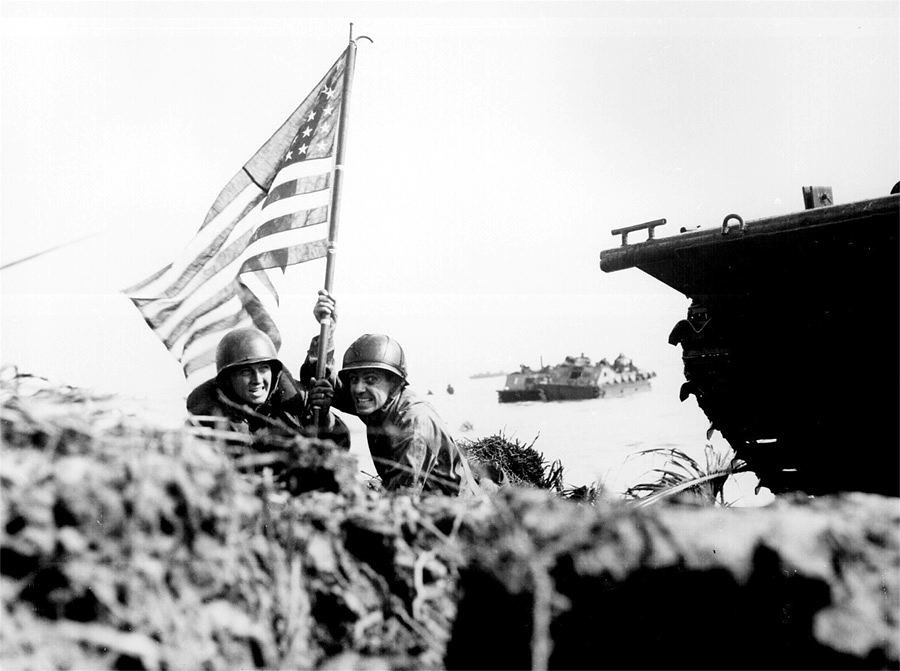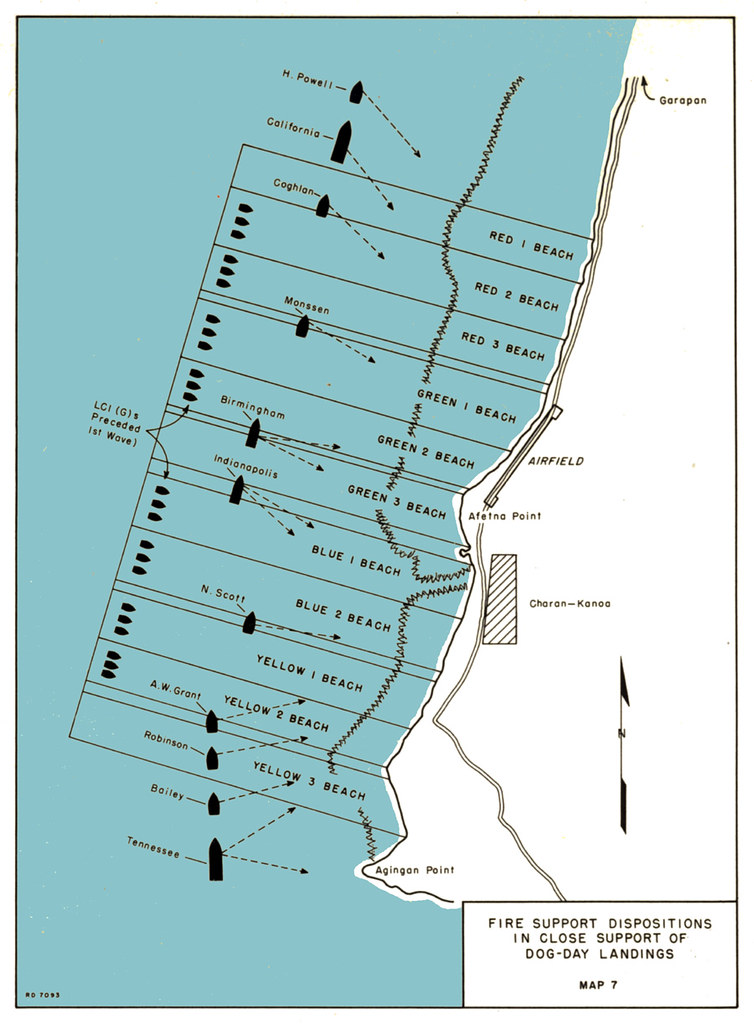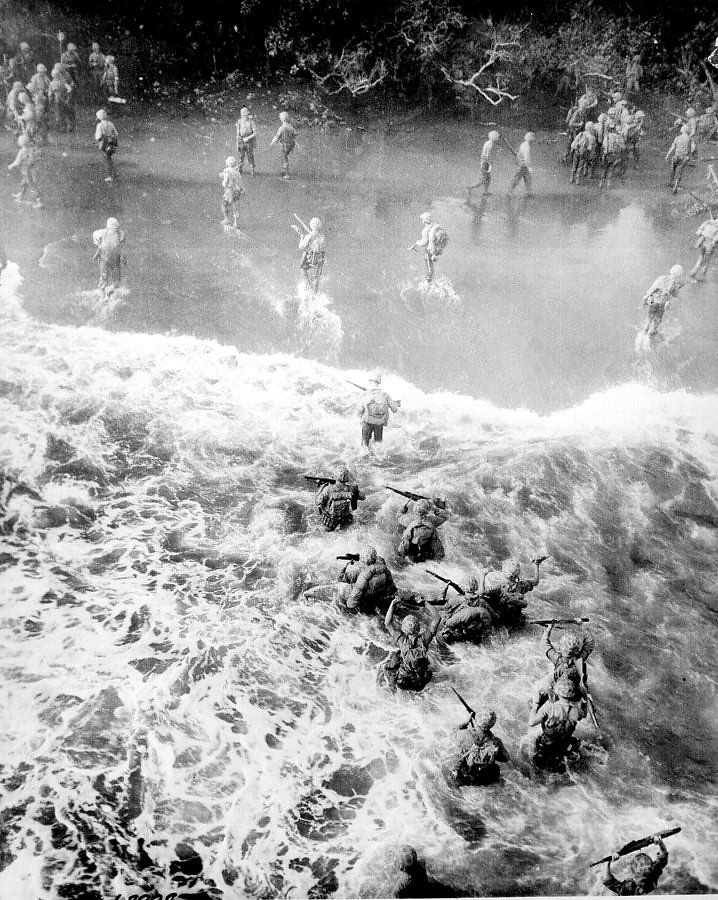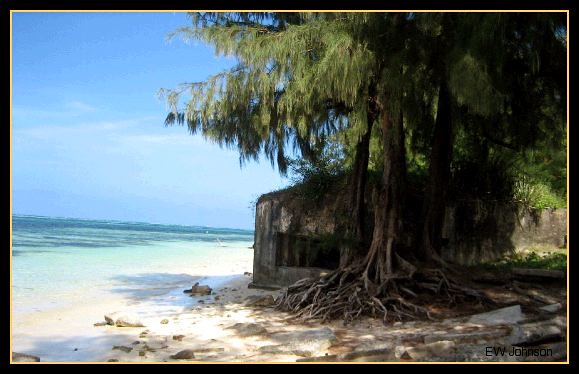|
Guam Invasion. After the battle of Saipan, U.S. troops invaded the island of Guam 500 miles south. I think this is a great picture and could easily have been any island in the Pacific war
|
Dog-Day + 0. This was the plan at 6:05 am June 15, 1944 when the order was given to board the landing craft. 8,000 U.S. Marines started the 20 minute trip to the beaches of Saipan. By the end of the first day nearly 2,000 were dead. Today few people know the color names of these beaches and even what actually happened there. |
|
| March 1944: Following in the cover of a tank, American infantrymen secure an area on Bougainville, Solomon Islands after Japanese forces infiltrated their lines during the night. (AP Photo) # June 1944: U.S. Marines move up the beach on Saipan under heavy machine gun fire, during landing operations at the island of the Mariana group. (AP Photo) # June 1944: A Japanese bomber is shot down as it attempted to attack the USS Kitkun Bay, near the Mariana Islands. (AP Photo) # June 1944: Two U.S. Marines are seen crawling to their assigned positions under enemy fire on the beach at Saipan, Mariana Islands. (AP Photo) # July 1944: Columns of troop-packed LCIs trail in the wake of a Coast Guard-manned transport ship en route for the invasion of Cape Sansapor, New Guinea. The deck of the LST is densely packed with heavy military machinery and other war supplies. (AP Photo) # July 1944: U.S. Marines walk away from a Japanese foxhole after blowing it up with explosives, during the invasion at Saipan, in the Mariana Islands. (AP Photo) # July 1944: U.S. Army reinforcement troops are seen as they disembark from LST's in the background and proceed across the coral reef toward Saipan beach, Mariana Islands. (AP Photo) # July 27, 1944: Flak fills the sky as U.S. antiaircraft guns fight off a Japanese attack during the invasion of Saipan, Mariana Islands. (AP Photo) # March 10, 1945: U.S. troops in the Pacific islands continued to find enemy holdouts long after the main Japanese forces had either surrendered or disappeared. Guam was considered cleared by August 12, 1944, but parts of the island were still dangerous half a year later. Here, patrolling Marines pass a dead Japanese sniper. These Marines may belong to the Fifty-second Defense Battalion, one of two black units sent to the Pacific. (Charles P. Gorry, AP Staff/AP Archives) # August 24, 1944: Curtiss Helldivers from the Fast Carrier Task Force 58 are seen midair on a mission over Saipan, in the Mariana Islands. (AP Photo)# September 13, 1944: Japanese-occupied harbor of Cebu is under attack by U.S. Navy carrier-based fighter planes, at Cebu island, Philippines. (AP Photo) # October 20, 1944: U.S. troops head toward the beaches of Leyte island during the amphibious assault to reconquest the Philippines. (AP Photo) # Nov. 1944: American soldiers take cover from fire of a Japanese machine gun in the Philippines during World War II. The troops are part of the first wave to land on Leyte Island in the Philippine invasion. (AP Photo/U.S. Army Signal Corps) # October 20, 1944: Gen. Douglas MacArthur, center, is accompanied by his officers and Sergio Osmena, president of the Philippines in exile, extreme left, as he wades ashore during landing operations at Leyte, Philippines, after U.S. forces recaptured the beach of the Japanese-occupied island. To his left is Lt. Gen. Richard K. Sutherland, his chief of staff. (AP Photo) # November 1944: A U.S. Marine flamethrowing tank attacks a Japanese pillbox, during the invasion of Saipan, in the Mariana Islands. (AP Photo) # November 12, 1944: U.S. medics are seen as they treat wounded comrades at an portable surgical unit during the 36th Division's drive on Pinwe, Burma. (AP Photo) # November 1944: Ground crew members prepare bombs to be loaded into the racks of the waiting B-29 Superforts, at a U.S. airbase on Saipan, in the Mariana Islands. (AP Photo) # November 1944: U.S. landing ship tanks are seen from above as they pour military equipment onto the shores of Leyte island, to support invading forces in the Philippines. (AP Photo) # November 1944: Two Coast Guard-manned landing ships open their jaws as U.S. soldiers line up to build sandbag piers out to the ramps, on Leyte island, Philippines. (AP Photo) # Nov. 25, 1944: Firefighters are almost hidden by smoke as they turn their hoses on many small fires started on the flight deck of the USS Intrepid after a Japanese suicide plane crashed into the carrier while it was operating off the coast of Luzon, the Philippines. (AP Photo/U.S. Navy) # Nov. 25, 1944: Wounded sailors are treated on the flight deck of the USS Intrepid after a Japanese suicide pilot crashed his plane on the carrier's deck while it sailed off the coast of Luzon, the Philippines, during World War II. (AP Photo/U.S. Navy) # Nov. 26, 1944: Burial at sea ceremonies are held aboard the USS Intrepid for members of the crew lost after the carrier was hit by a Japanese suicide pilot while operating off the coast of Luzon, the Philippines, during World War II. Sixteen men were killed in the kamikaze attack. (AP Photo/U.S. Navy) # December 12, 1944: After being hit in a Japanese air raid, a B-29 Superfortress explodes in ball of fire, while crewmen of the U.S. air base try to fight the inferno on Saipan, Mariana Islands. (AP Photo) # December 1944: U.S. soldiers at the Saipan airbase, in the Mariana Islands, watch as a B-29 Superfortress takes off for an air raid on the Japanese mainland. (AP Photo) # Feb. 1945: U.S. paratroopers of the 503rd Paratroop Regiment float to earth on Corregidor, a rocky island strategically located at the entrance of Manila Bay on Luzon Island, Philippines during World War II. (AP Photo/U.S. Army Signal Corps) # Feb. 13, 1945: Two Yank Infantrymen of the hard fighting 37th American division, climb through some Japanese barbed wire during street fighting in Manila in the Philippines. (AP Photo) |
Tinian InvasionAfter the Battle of Saipan the 2nd and 4th Marine divisions invaded Tinian island two miles south. For the 2nd Marines this was the fourth beach invasion in 18 months. American naval warships and landing craft staged a fake landing on the southern beaches of Tinian, which was the only logical invasion location. The Japanese pulled troops from around Tinian and sent them south for their defense of the island. Troop transports then returned to a small beach in the north of Tinian where the Marines simply walked to shore. It was a near perfect beach invasion.
Beach Bunker 3A Japanese WWII bunker on invasion beach in Saipan. In the morning on June 15, 1944 tens of thousands of U.S. Marines landed on this beach at the start of the three week battle of Saipan.
Guam in the Mariana Islands is pictured on Jul. 27, 1944, during U.S./Japanese warfare
March 10, 1945: U.S. troops in the Pacific islands continued to find enemy holdouts long after the main Japanese forces had either surrendered or disappeared. Guam was considered cleared by August 12, 1944, but parts of the island were still dangerous half a year later. Here, patrolling Marines pass a dead Japanese sniper. These Marines may belong to the Fifty-second Defense Battalion, one of two black units sent to the Pacific.
The precipice in the picture above is known as Suicide Cliff, off which over 20,000 Japanese civilians jumped to their deaths to comply with their fascist emperor's desire - mothers flinging their babies off the cliff first or in their arms as they jumped.
Near the Bird Sanctuary. Ashore on Saipan a Japanese soldier, member of the 9th Tank Regiment, wrote of the strike in his diary: At a little after 1300, I was awakened by the air raid alarm and immediately led all men into the trench. Scores of enemy Grumman fighters began strafing and bombing Aslito airfield and Garapan. For about two hours, the enemy planes ran amuck and finally left leisurely amidst the unparallelledly inaccurate antiaircraft fire. All we could do was watch helplessly. At night we went to extinguish the mountain fires which had been caused by gun fire. They were finally brought completely under control. In spite of the magnitude of the attack, the Japanese command on Saipan apparently did not realize on the 11th that this was the prologue to a full-size invasion. General Saito felt that in "the event of a battle occurring at the shore, there would be a great danger of the direction of the battle being hindered by an immediate interruption of communication.
Marines land on coral reefs during U.S./Japanese warfare, Guam, Mariana Islands, Jul. 21, 1944. |










No comments:
Post a Comment